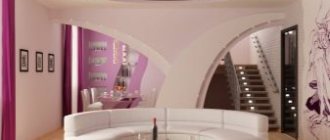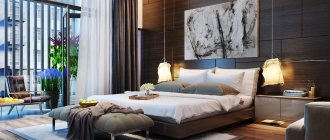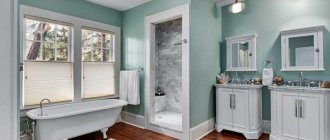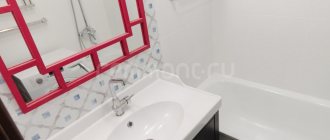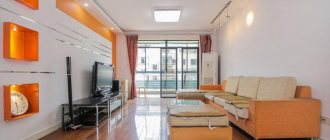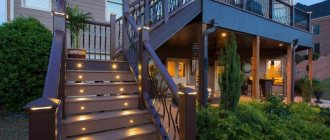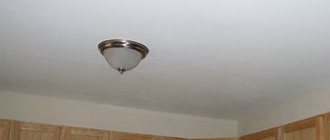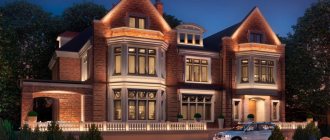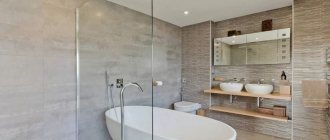The choice of lighting devices for suspended ceilings is quite wide; there are many more options than with the traditional finishing method. You can create not only a comfortable and original atmosphere in the house, but also visually adjust the shape or size of the room. Let us consider in detail what lighting devices are used on suspended ceilings, how to choose and place them correctly. We will also talk about the types of decorative lighting and ways of zoning space using light.
Basic requirements for light bulbs and lighting fixtures
Due to the characteristics of PVC film, which is used as a canvas for suspended ceilings, certain requirements are imposed on lighting devices:
- the lamp should not heat above 60°C - high temperatures lead to deformation of the canvas;
- there are no sharp corners or other protrusions on the device body that could damage the PVC film;
- lamps for recessed luminaires must be equipped with a reflector so that the light does not spread into the ceiling space.
It is recommended to lay all wiring in corrugated plastic pipes, which protect against sparks hitting the canvas in the event of a short circuit. When installing lamps, thermal rings must be used to protect the PVC film from deformation and overheating.
When choosing lighting for a stretch ceiling, pay attention not only to the lampshade, but also to the types of lamps. They come in four types:
- Incandescent lamps . The most affordable. But the permissible power is no more than 40 W due to the strong heating of their body.
- Halogen . Compared to previous products, they are distinguished by a long service life and an abundance of colors and shapes. But such lamps also get very hot and can melt the canvas. The power should not exceed 35 W.
- Energy saving (luminescent). They are widely used in tension structures because they heat up slightly. But they are more expensive than incandescent lamps and halogen analogues, and the range of models is small. Maximum efficiency is observed only with constant work. If you turn it on and off frequently, the electricity consumption during heating increases several times. In addition, energy-saving lamps do not light up immediately and begin to work at full power only after a while (3-5 seconds).
- Light-emitting diode (LED). They practically do not heat up, have a comfortable glow for the eyes, are durable and economical. The model range is very diverse; you can find a suitable shape and size for almost any lamp. Unlike fluorescent ones, they instantly turn on at full power. But their disadvantage is their high price.
It is best to choose LED and energy-saving lamps. They do not overheat the stretch fabric, so they have no restrictions when used with this type of finish, they consume energy more economically and last a long time.
When purchasing a lighting fixture, pay attention to the base model. Now the most common:
- G5.3 for halogen and LED devices;
- GX53 for LED and energy saving devices.
LED lamps with GX53 socket are the most profitable because they are manufactured using advanced technologies. But their design must have a cooling grille, which is made of metal or composite materials, and extends the service life of the device.
Square
Non-standard shapes are often used in extraordinary styles. These include square lighting fixtures. As a rule, these are ceiling lamps with shades in the form of a cube or flat shape . These devices ideally emphasize the even angles and clear lines of the room.
These lighting options are suitable for rooms of any size: with low and high ceilings, with narrow or wide walls. Manufacturers make square lamps with several or more bulbs.
Square lamps for non-standard styles
Nuances of choosing lighting depending on the texture of the canvas
When thinking about the design of a room, they take into account the function that certain lighting fixtures should perform. Depending on this, there are three types of lighting:
- The main thing is to create a soft, homogeneous environment for the entire room.
- Local - designed to locally illuminate a specific area in a room, such as a desk in the living room, a reading area in the bedroom, or a cooking area in the kitchen.
- Accent - used to attract attention to individual interior objects: a painting, a mirror, a niche, etc. Such light sources allow you to concentrate the beam on a specific object and are installed only where they are needed.
It is advisable to avoid direct eye contact with the light source. Proper lighting design means that a person does not notice the light bulbs at all. Therefore, it is important to consider the texture of the canvas.
There are three main types of film surfaces used in stretch ceilings: matte, glossy and satin.
Glossy coatings reflect light better than others. They are installed in rooms that need to be visually expanded. The smooth lacquer surface clearly reflects interior items.
For such paintings, horn-type chandeliers directed upward are not suitable. They, like a mirror, reflect the inside of the lampshades, and the glare from the lamps will be very noticeable. Therefore, they choose models with horns pointing down. In this case, the distance from the ceiling when using incandescent lamps should be at least 25 cm.
Hanging lamps with crystal shades look beautiful on such ceilings. The edges are reflected in the glossy surface and create sparkling highlights.
Matte stretch fabrics , imitating a painted surface, practically do not reflect light, and therefore reduce its brightness. LED strips and turned lamps with a downward beam look good on this finish.
The satin texture softly reflects and diffuses light, and the shade can change depending on the viewing angle. On such canvases beautiful dim highlights with a pearlescent shimmer are formed.
Materials
Various materials are used to make recessed ceiling lamps. The base part is made of heat-resistant plastic or metal. A special coating is applied on top to make the surface smooth. Regardless of the surface to which a standard light fixture is attached, it will look the same in almost all cases.
Crystal pendants mounted on the surface of the lamp will look original and unique. Such devices look great in living rooms and hallways, but not everyone can afford to buy them. To economically decorate an ordinary lamp, you can attach glass pendants to it.
How to choose the color temperature of lamps for the interior
Artificial and natural light have a hue called color temperature, measured in Kelvin (K). Morning and evening light is warm (2700-3000 K). In winter, in cloudy weather, the tone is cold (5000-6500 K), during the day - neutral (4000-4100 K).
Color temperature affects people's mood and is selected depending on the purpose of the room. So, in the office, bathroom, dressing room, you can install invigorating cold light. Relaxing warm lighting is more suitable for the bedroom and nursery.
Interior design is also taken into account. Lamps with a range of 2700-3000 K produce rich colors with a warm component. Cold colors, on the contrary, darken and are perceived differently, for example, blue looks black.
This lighting is suitable for small rooms with a lot of wood and textiles. These materials are more often found in styles: eco, modern, rustic and classic.
The range above 5000 K makes the colors of the blue spectrum more saturated - gray, blue. Warm shades lose their brightness, yellow appears greenish.
Cold lighting is more suitable for large rooms, filling them with “air”, and is appropriate in simple interiors where there is a lot of geometry and contrast. This is inherent in the styles of minimalism, futurism and hi-tech.
If you do not have enough experience in selecting lighting for suspended ceilings, then it is better to choose light bulbs with an indicator of 4000 K. Neutral lighting has a number of advantages:
- the color of the finish is not distorted;
- almost imperceptible effect on mood;
- a compromise option for work and rest areas.
Designers also have this rule: all light bulbs in a room should be either warm or cool color temperature to ensure uniformity of the environment. But it is permissible to make an exception for accent lighting if it is necessary to highlight a texture or a separate object.
Ceiling
Ceiling lamps are common in today's interiors. In the variety of possible designs, they are often superior to any other model.
Ceiling lamps include:
- chandeliers and ceiling lamps;
- overhead lamps;
- pendants with shades.
All similar models are securely attached to the ceiling, without visually taking up space. Ceiling lights are perfect for rooms with low ceilings.
Options for lamps in one room
Lighting fixtures are often selected to match the style of the room. So, for strict classics, pendant lamps with overhead shades are suitable. Modern and loft styles are more suitable for square or non-standard shape appliances.
Ceiling devices are also distinguished by the type of light:
- directional;
- scattered.
This allows them to illuminate both large and small rooms.
When you don't need a lot of light
Chandelier in an interior with suspended ceilings
This is a classic device for basic lighting in large rooms. Any model that matches the overall style will suit an ordinary room. But for suspended ceilings you need to take into account the characteristics of the material:
- flat lampshades must be equipped with a metal diffuser, which will protect the PVC film from heating, reflecting heat and increasing brightness;
- It is recommended to point the lampshades downwards so that dark spots do not appear on the canvas over time;
- When using incandescent lamps, it is important to maintain a minimum distance to the ceiling of 25 cm.
Most often, LED strips and spots are additionally installed.
When buying a chandelier, take into account its size. The following formula helps determine the correct diameter:
d chandeliers (cm) = (room length (m) + room width (m)) x 10.
So, a room 3 x 4 meters will require a light source measuring 70 cm ((3+4) x 10).
The height of the chandelier should be such that there is at least 190 cm to the floor. The optimal parameter is determined by dividing the height of the room by 4. The device is placed in the center of the ceiling or in the middle of the functional area.
Scope of application
Recessed spotlights can be used in rooms for various purposes. We are talking about both residential, office and industrial facilities. Some devices are used in street lighting, to illuminate exhibits at exhibitions or architectural structures. And yet the main area of application is in everyday life.
For production workshops, products with reinforced casings are required; for bathrooms, shower rooms, and swimming pools - devices with a sealed casing that protects the light source from splashes and condensation.
Distribution schemes for spotlights and spots
Spotlights are small devices designed for one light bulb. Such devices are most often used with suspended ceilings due to their ease of installation and a huge range of models. They often replace a chandelier, obtaining the same brightness of lighting.
Depending on the design there are:
- built-in (mortise) - mounted almost flush with the ceiling;
- overhead - protrude beyond the plane of the canvas.
They are made from different materials - plastic, glass, plaster, ceramics. Some are decorated with LED lighting along the edge of the case, crystal pendants and other decorative overlays. Also on the market are devices with a rotating mechanism that allow you to change the direction of the light beam; such models are called spots. Available with a single light bulb or several combined in one housing.
Place spotlights according to the following rules:
- distance from walls - at least 20 cm;
- distance from the weld seam, if the fabric is soldered from several parts of the film - at least 15 cm;
- distance between lamps - from 30 cm;
- one spot - for 1.5–2 m² of area;
- The norm of illumination per 1 m² of a living room is 150–200 Lux, for a bathroom, a toilet - 50 Lux, an office - 300 Lux.
The chandelier is always placed in the center. Spotlights can be installed:
- along the long side of the wall - lined up in a row or in an arc;
- in the corners of the room - singly (in small rooms) or in groups of 3-5 pieces;
- on two opposite sides - straight or in an arc;
- along an oval;
- around the circumference and in the corners of the room.
- on two adjacent walls;
- along the perimeter.
It is convenient to place rotating spots along the working area, directing the beam directly at it.
If multi-level structures are used, then spotlights are most often installed only on the upper or lower tier. In the second case, a beautiful background frame is created.
Depending on the configuration of the room, the following placement will be optimal:
- hallway - along the ceiling in the center or in several rows in parallel;
- kitchen - chandelier above the dining table, work area - spot lighting in a line or zigzag;
- hall - any placement is allowed, with or without a chandelier. But in the latter case, an arc-shaped scheme is relevant, where in the center there is one spotlight of higher power;
- bedroom - you don’t have to install a chandelier, but place the spots in a circle, oval, zigzag or checkerboard pattern;
- children's room - a chandelier is usually hung in the center of the room, and spotlights are placed in the work area where the desk is;
- bathroom - in a spacious room, a lampshade can be placed above the font, and spots above the mirror; in a small room, “dots” can be placed symmetrically along the walls, etc.
Adjusting the direction of the light
According to the type of design, recessed ceiling lamps are distinguished:
- Fixed mechanisms;
- Rotary structures.
Fixed structures provide for complete fixation of the lampshade to the body, thus creating uniform illumination of the room. But often, in order to increase the functionality of lighting devices, lamp designs are equipped with rotating mechanisms, which, in turn, allow you to change the direction of the light flux.
Any type of recessed luminaires, both spotlights and pendants, can be equipped with a rotating mechanism.
Thanks to the wide product range, you can purchase rotary lamps for both plasterboard structures and suspended ceilings.
In addition, a significant advantage is the presence of small-sized models that allow you to install a lighting source in furniture, which is an ergonomic solution when organizing a work area.
Rotating mechanisms of recessed luminaires increase the service life of the product.
This occurs due to the fact that when the lampshade is rotated, free space is created, which allows the structural elements to be cooled more efficiently.
In addition to adjusting the direction of the light flux, it is possible to change the brightness level of the lighting fixture.
To do this, the lighting elements must be equipped with a dimmer or dimmer, which, by changing the energy flow in the rheostat, affects the voltage level, which leads to an increase or decrease in the brightness of the lamp.
In other words, a dimmer is an improved switch with an additional function of adjusting the degree of illumination.
The dimmer can be mechanically controlled - this is the most common type of dimmer. But besides this, there are electronic, acoustic and remote dimmers.
Modern spot systems
In addition to point spots, there are even more convenient and movable models - track lamps. These are pendant-type devices attached to the ceiling on a busbar, which can be flexible, inflexible, or in the form of a cable. The luminaires can be easily moved along the entire length of the track. More often they are installed in museums, exhibition halls, cafes and offices. However, they are also convenient in rooms - for example, in the kitchen or in the office, above the children's desk.
The peculiarity of such spot systems is that the busbar can be installed not only on the ceiling, but also on a horizontal plane. Such devices are well suited for accent lighting. Thanks to the rotating and movable mechanism, the lamp can be directed in any direction.
Mounting methods
Ceiling lighting varies in mounting methods.
- Invoice. It is attached to special overhead profiles installed on the ceiling during power supply.
- Built-in. The devices are installed using a spring mechanism, ensuring a tight fit of the body to the canvas.
- Hanging. The easiest way is to install chandeliers by hanging them on a hook attached to the ceiling slab.
LED panels and ultra-thin LED luminaires
This is a new generation of devices that use diodes as a lighting element. When installed, they occupy a minimum of inter-ceiling space - the thickness is only 20 mm. Some devices are quite large, but due to the use of LEDs, they do not overheat the suspended ceiling.
One of the main advantages is the built-in lighting elements, so there is no need to change light bulbs. On the other hand, if the device has exhausted its service life, it will have to be replaced entirely. But the service life of such devices is more than 50,000 hours.
The panels are produced mainly round and square, but there are also designer models of non-standard shapes. Thanks to this, it is possible to create amazing and unusual compositions on a stretch ceiling.
Built-in
Built-in lamps in the design of the room are almost invisible. They are purchased with a single purpose - to illuminate the space. And not to decorate the interior of a home or office.
According to their structure, built-in lamps are divided into:
- modular (panel);
- furniture (spot).
Built-in model
The nature of the lighting of devices can be directional or diffuse. The depth of its “built-inness” is measured by the completeness or partiality of the installation.
In the interior of premises, built-in lamps can be seen in furniture or in plasterboard structures.
LED strips as main and additional lighting
LED strip is a thin flexible strip no more than 1 mm thick, into which tiny lighting elements (LEDs) are inserted. Its compact dimensions make it invisible; the tape is installed in a special groove in the stretch ceiling baguette and is completely hidden by the structure.
The device operates from a 12–24 V current source. Power is supplied from the network through a converter unit. Control is often carried out using an IR remote control. The strip is easily attached to the supporting structure thanks to the adhesive layer on the reverse side.
Lighting with LED strip has several advantages:
- diffused light flux;
- fire safety;
- easy installation;
- air enters the light source.
Depending on the color of the LED strip, there are:
- neon - ideal for a modern living room;
- white - used most often in small rooms;
- yellow - give comfort to large rooms;
- green - for additional illumination;
- purple - create a “cosmic” atmosphere;
- multi-color (RGB) - color can be switched using the remote control.
LED strip can be used as main lighting, but is more often used for additional decorative lighting. It is so versatile that it opens up almost limitless design possibilities. Let's look at the most popular ways to use LED strips with a stretch ceiling.
Contour lighting around the perimeter
In this case, the tape is installed along the edge of the canvas in a special profile with a groove, and covered with a translucent film on top. The effect is achieved due to the throughput of the finishing material. When the backlight is turned off, the outer contour and the canvas form a single plane of the ceiling.
An alternative option is 3D backlighting. For this design, a profile of a different shape is produced. In it, the canvas around the perimeter is not stretched perpendicular to the wall, but at an acute angle.
Contour lighting creates a feeling of weightlessness and visually expands the room. This property is used in small rooms - for example, in a narrow corridor. The effect is especially strong when installing white films in combination with a neutral or yellow glow. When the lighting is turned off, the canvas takes on a classic look.
floating ceiling
When entering such a room, a person may think that there are windows around the perimeter of the ceiling through which sunlight penetrates. To create this illusion, special profiles are used, which are fixed not close to the wall, but at some distance. An LED strip is installed in this space. Due to the hidden lighting, it looks as if the ceiling does not touch the walls and is floating in the air.
Soaring ceilings look unusual and futuristic. The room gains more volume, the relief of the walls and the beauty of the curtains are emphasized. Typically, strips with a white glow are used, but color RGB models are also installed.
LED lighting in the profile can complement the main light source or be used independently - for example, during a movie show or a break from work.
Interlevel lighting
This lighting method is found only in multi-tiered ceiling structures. The LED strip is mounted in a special niche between the levels to emphasize the transition line.
Interlevel lighting allows you to achieve the necessary aesthetic and visual effects. The design looks especially expressive with films of various textures and colors. In this way, the room is divided into zones and its dimensions are adjusted.
Glowing ceiling
To create this effect, LEDs are installed behind the tension fabric. LED strips are attached to the base ceiling and covered with a translucent PVC film that transmits and diffuses light. The ceiling turns into one huge lampshade. When the light is off, the surface looks like a regular canvas.
But you should keep in mind: to make such a non-standard ceiling, you need to significantly reduce the height of the room. The larger space ensures even light dispersion. Sometimes reflective coatings are additionally placed behind the main film.
A luminous ceiling is made over the entire surface or as a separate fragment, usually in the center of the structure. The canvas with photo printing looks impressive. This way you can recreate an imitation of a window, sky, nature in a room.
Light lines
To create light lines, special profiles with a niche for an LED strip are used. On the canvas itself, in the places where the beam is projected, a translucent film or light-scattering plugs are installed, on the rest of the surface - a regular canvas.
LED strips create a bright but diffused beam, and can act as a full-fledged light source, without a chandelier or other devices. Such lighting looks especially advantageous in a modern interior.
The thickness, length and location of raster light sources can be different: spread over the entire surface of the ceiling, form closed, intersecting figures, wavy and zigzag lines. The stripes will highlight the desired areas and visually adjust the configuration of the room.
In addition to profile systems with LED strips, linear lamps are used to create a similar effect on stretch ceilings. This is another modern and aesthetic device that replaces fluorescent lamps. But, unlike the latter, it does not flicker and consumes less electricity, does not require special disposal and can be of various lengths, which allows you to create a variety of compositions. Linear luminaires are also used in suspended ceilings.
Read more: How to make floating light lines on a stretch ceiling
Light patterns
The essence of the technology is that an LED strip is placed behind the canvas in special baguettes, forming light patterns. Profiles correct the direction of illumination, and the beam is scattered in only one direction. These ceilings look extraordinary.
The LED strip has good flexibility, which allows you to create a wide variety of intricately shaped patterns, limited only by the designer’s imagination. Interesting compositions are obtained using perforated canvases. Light penetrates through small holes, creating an unusual pattern above the head. But such techniques are used only as decorative lighting in addition to the main lighting.
Rotary
These models include:
- sconce;
- wall lamps;
- ceiling chandeliers.
These lighting elements are often used in the interior of balconies, loggias, long hallways and corridors. That is, in those rooms that do not need a lot of light, but sometimes it is necessary to illuminate one particular area more than another.
We illuminate a certain area in the room
Decorative lighting at night
A stretch ceiling can be turned into one large night light. Such solutions are relevant for a children's room, bedroom and living room, where people stay up late. Let's consider several options for implementing this task.
Starry sky
Such compositions are most often installed in the bedroom and nursery; they create a romantic and cozy atmosphere. The effect of the night sky is achieved in several ways:
- Photo printing with backlight . A thematic design (night sky, cluster of galaxies or constellations) is applied to the film. LED strips are fixed above the canvas, which illuminate the image from the inside, especially the light areas. The composition looks very realistic.
- Optical fiber . This is a more expensive and difficult to implement option. Before installation, punctures are made in the canvas, into which fiber-optic threads connected to the projector are inserted. As a result, the ends of the optical fiber transmit the glow from the projector, forming a fairly realistic map of the starry sky. An even more vivid impression arises if you use a canvas depicting space. Microscopic lighting elements will complement the picture, repeating the twinkling of stars. The threads come in different thicknesses, which is why the glow is uneven and very similar to the real night sky.
- Starpins pins . This design is considered a simpler and more affordable alternative to the fiber optic analogue. These are light-conducting needle-shaped elements of different colors and sizes, made of plastic. An LED strip is used as a lighting source, attached behind the canvas to the concrete floor. As a result, a slight glow is transmitted through the pins, reminiscent of the twinkling of stars.
Fiber optic threads and Starpins can be arranged in any order: chaotically, imitating the real night sky, in the form of constellations or even zodiac signs. Often such lighting is complemented by a remote control, which allows you to adjust the color and brightness of the stars.
Ability to change brightness in devices
The latest trend in lighting design is equipment that adapts to natural human biorhythms. Adjustment devices allow you to select cold or warm glow temperatures and set the desired brightness. Such devices are tied to light sensors, and the system itself will change the light temperature depending on the time of day in order to repeat the natural biorhythm.
A simpler and cheaper option is to connect a dimer, which allows you to smoothly change the electrical power, thereby adjusting the brightness of the lighting.
Zoning and adjusting space using light
Lighting on a suspended ceiling often divides a room into functional zones, and also corrects geometry or size.
To zone a room, several different types of devices are used. For example, the dining table in the kitchen can be highlighted with a chandelier, and the cooking area can be highlighted with a set of spots. In the bedroom, this technique helps to delimit areas for relaxation and sleep; in the nursery, it helps to separate the play area.
The right lighting can “turn on” and “turn off” certain areas of the room, bring them into play or hide them. This allows you to visually adjust the shape, making the room cozy and functional.
Here are some tricks to help solve problems with proportions:
- reflected bright light, especially concentrated in the corners, will visually increase the space;
- a square room can be lengthened a little by installing LEDs above parallel walls;
- a narrow room seems wider when the lighting is located only along one long wall;
- a wide room is “narrowed” with the help of spotlights placed along the transverse axis of the ceiling;
- a rectangular room looks square if three walls are illuminated equally, and the distant narrow one is accented;
- the flow of light from the chandelier directed upward adds height, this effect is especially noticeable on varnish and satin textures; low ceilings will also visually lift the sconces in combination with the glossy surface of the tension structure;
- illumination with an LED strip hidden in the ceiling cornice on short walls will optically expand them;
- with a certain shape and location of the color spot, you can create the illusion of a slope, like in an attic.
Light interacts with furnishings. With its help, objects are hidden or emphasized, brought closer or further away. An old-fashioned sofa is given the look of an expensive item from a fashion boutique, and faded curtains are given back their lost color.
Examples and ideas for lighting suspended ceilings
Finally, it is worth noting that the lighting concept should develop in parallel with interior planning. This approach will help to highlight the texture of the walls, highlight the beauty of the furniture surface and ceiling trim, and fully reveal the designer’s idea. Your hard work will be rewarded - your home will be comfortable and stylish.
